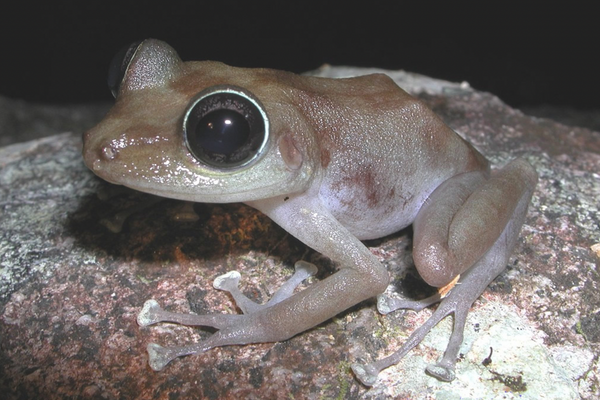Studying the World’s Largest Parrot Colony Is an Extreme Sport
Cliffside with Argentina’s burrowing parrots, biologist Juan Masello has broken bones, crushed a vein, and nearly drowned.
Buffeted by the wind, Juan Masello was 80 feet above the surf, rappelling from the jagged cliff face. Ignoring memories of splintered bones and brushes with death, he focused on reaching the ledge beneath the overhang. There he found the crevices he had been looking for. He unfurled a telescopic stick with a curious spoon at its tip, and inserted it into one of the gaps in the rock face, withdrawing it moments later. On its end perched a disgruntled bundle of khaki feathers—a burrowing parrot chick—which he placed gently into a cloth bag and lowered by rope to be weighed by the team gathered on the beach below.
For the past two decades, Masello, a researcher at the University of Bielefeld, has risked life and limb to study the world’s largest parrot colony and unravel the unique burrowing behavior of the animals. Along the way, he has become a champion of the species. It is a career path he never anticipated.
In the winter of 1998, Masello returned to Argentina after a failed doctoral project in Antarctica that had discouraged him from a career in microbiology. Invited by a friend to vacation on the Rio Negro coast, he set out one day to do some birdwatching. He headed to the cliffs of Balneario El Condor and stumbled upon the parrot colony by accident.
The parrots hadn’t yet arrived, and the escarpment was desolate, but the gothic look of the place inspired him to return. A few months later, he was back, greeted by thousands of olive-colored parrots whirling over the beach. Their ear-splitting jabbering drowned out even the crashing waves. It was love at first sight for the biologist.

“I’d spent years in a lab staring at dead microorganisms down a microscope, but the parrots were different; they were alive and beautiful,” says Masello. They were also mysterious. “The colony had never been fully researched, and I had a feeling that the site was much more important than anybody had recognized previously.”
Native to a broad sweep of Chile and Argentina, the burrowing parrot (Cyanoliseus patagonus) thrives in diverse habitats, from the arid deserts of the north to the freezing steppes of southernmost Patagonia. Populations typically migrate seasonally and, each October as spring arrives, parrots from all over central and southern Argentina flock to Balneario El Condor for the favorable climate, better feeding prospects, and, above all, for the 12 kilometers (roughly eight miles) of sprawling cliffs.
True to its name, the burrowing parrot is a prolific tunneler—a behavior not seen in any other parrot species. Burrowing is believed to have evolved in response to the lack of trees in Patagonia and its harsh climate, leading these parrots to nest in habitats with limestone and sandstone cliffs or canyons where they are able to dig. Using their beaks and claws to chip away at the rock, the birds excavate tunnels up to nine feet long, providing a sheltered nesting space where monogamous pairs rear their chicks. In fact, “the drive to dig is so strong” in the species, says Masello, that nest cams have shown baby birds honing their excavation skills as soon as their feathers start to grow.
During each nesting season, about 74,000 individuals descend on Balneario El Condor, making it the world’s largest parrot colony, and the most important breeding site for the burrowing parrot. “The gut feeling I had all those years ago turned out to be correct,” says Masello. “We found that over 70 percent of the species’ population nest here, so it’s a critical area for their survival.”

Studying the parrots is not for the faint-hearted. Reaching the nest sites involves rappelling down sheer cliffs—a skill that Masello acquired on the job, having no prior climbing experience. It was a daunting learning curve: He narrowly survived rock falls and the threat of ropes snapping, which would have sent him tumbling to his death. On one occasion, Masello, his wife, and their toddler almost drowned when a high tide nearly cut off their escape route.
Over decades of danger, Masello became a seasoned climber—though he bears the physical toll. In addition to head, pelvis*, hip, and eye injuries, he has broken multiple bones and even had to have a saphenous vein, crushed from hours spent in a harness, removed. “I’m in big trouble if I ever need a bypass,” Masello says.
Alas, not everyone shares the biologist’s all-consuming parrot passion or a desire to better understand the birds.
In Argentina, the burrowing parrot has long been considered a pest due to the mistaken belief that it raids crops and causes cliff erosion with all that burrowing. As recently as the early 1990s, official government policy allowed for the culling and destruction of colonies through poison, blowing up nesting sites with dynamite, and capturing birds for the pet trade.
“It was a belief based on pure ignorance,” says Masello, who adds that 99 percent of the birds’ diet comes from spiny scrubland plants, not crops, and that waves are responsible for coastal erosion. Yet while the parrots of Balneario El Condor are no longer directly persecuted, their habitat remains under a state of constant siege.

The growing nearby town is increasingly encroaching upon the colony, and crops have replaced much of the scrubland the parrots feed on. The shortage of habitat, coupled with El Niño and La Niña events that disrupt the fruiting of native plants, has led to mass starvation events. Concrete footpaths, hang glider runways, and a war memorial have been built alongside nesting sites. Burrows have collapsed, and others remain empty as human activity stresses the birds and drives them away. “It’s not just a tragedy for the parrots but for the town itself. This site is unique and could have enormous tourist potential to benefit the local economy,” says Mauricio Failla, a local biologist and part of Masello’s team.
To save the colony, Masello and his colleagues have started to replant native vegetation, educate the local population about the parrots, and campaign for the creation of a reserve. While the dream of a protected area hasn’t yet materialized, the town has started to embrace their noisy neighbors and the idea of their conservation.
“It’s becoming a lot more common to hear people say to visitors, ‘We have the largest parrot colony in the world right on our doorstep,’” says Failla.
For Masello, who has no intentions of ceasing his cliff-climbing for the foreseeable future, the pursuit of his passion for the Patagonian parrots persists despite the perils. “It’s dangerous work… and I’m not getting any younger,” he says. “But these birds are like my children; without them, life just wouldn’t be the same. I plan to keep doing this for as long as my body allows me to.”
*Correction: This story previously stated that Masello had broken his pelvis multiple times. He has never broken his pelvis.


























Follow us on Twitter to get the latest on the world's hidden wonders.
Like us on Facebook to get the latest on the world's hidden wonders.
Follow us on Twitter Like us on Facebook